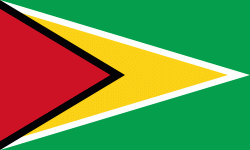Upper Takutu-Upper Essequibo (Upper Takutu-Upper Essequibo Region)
Upper Takutu-Upper Esequibo (Region 9) is a region of Guyana. Venezuela claims the territory as part of Bolívar (state) in Esequiban Guyana.
It borders the region of Potaro-Siparuni to the north, the region of East Berbice-Corentyne to the east and Brazil to the south and west. It contains the town of Lethem, and the villages of Aishalton, Nappi and Surama. It is also the largest region of Guyana.
The Rupununi savannah known for its large biodiversity is located between the Rupununi River and the Brazilian border.
The Government of Guyana has administered three official censuses since the 1980 administrative reforms, in 1980, 1991 and 2002. In 2012, the population of Upper Takutu-Upper Essequibo was recorded at 24,212 people. Official census records for the population of the Upper Takutu-Upper Essequibo region are as follows:
* 2012 : 24,212
* 2002 : 19,387
* 1991 : 15,058
* 1980 : 12,873
It borders the region of Potaro-Siparuni to the north, the region of East Berbice-Corentyne to the east and Brazil to the south and west. It contains the town of Lethem, and the villages of Aishalton, Nappi and Surama. It is also the largest region of Guyana.
The Rupununi savannah known for its large biodiversity is located between the Rupununi River and the Brazilian border.
The Government of Guyana has administered three official censuses since the 1980 administrative reforms, in 1980, 1991 and 2002. In 2012, the population of Upper Takutu-Upper Essequibo was recorded at 24,212 people. Official census records for the population of the Upper Takutu-Upper Essequibo region are as follows:
* 2012 : 24,212
* 2002 : 19,387
* 1991 : 15,058
* 1980 : 12,873
Map - Upper Takutu-Upper Essequibo (Upper Takutu-Upper Essequibo Region)
Map
Country - Guyana
 |
 |
| Flag of Guyana | |
The region known as "the Guianas" consists of the large shield landmass north of the Amazon River and east of the Orinoco River known as the "land of many waters". Nine indigenous tribes reside in Guyana: the Wai Wai, Macushi, Patamona, Lokono, Kalina, Wapishana, Pemon, Akawaio and Warao. Historically dominated by the Lokono and Kalina tribes, Guyana was colonised by the Dutch before coming under British control in the late 18th century. It was governed as British Guiana, with a mostly plantation-style economy until the 1950s. It gained independence in 1966, and officially became a republic within the Commonwealth of Nations in 1970. The legacy of British rule is reflected in the country's political administration and diverse population, which includes Indian, African, Indigenous, Chinese, Portuguese, other European, and various multiracial groups. In 2017, 41% of the population of Guyana lived below the poverty line.
Currency / Language
| ISO | Currency | Symbol | Significant figures |
|---|---|---|---|
| GYD | Guyanese dollar | $ | 2 |
| ISO | Language |
|---|---|
| EN | English language |















